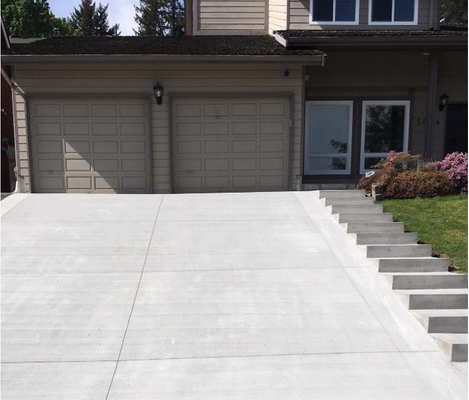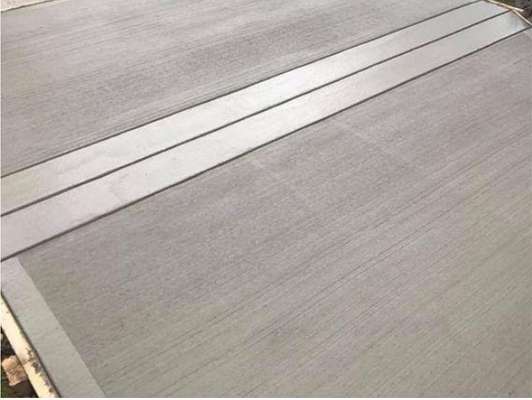Broom Finished
Broom Finished Concrete
What Is Concrete?
Concrete is a mixture of cement, air, water, sand, and gravel — it's as simple as that! Well, not exactly. The typical concrete mix is made up of roughly 10% cement, 20% air and water, 30% sand, and 40% gravel.
Although the terms cement and concrete often are used interchangeably, cement is actually an ingredient of concrete. Concrete is a mixture of aggregates and paste — the aggregates are sand and gravel or crushed stone while the paste is water and portland cement.
Not surprisingly, designers and artists have discovered that concrete is a living material that responds to their hands and then goes on from this responsive plastic state to become a hardened, permanent, complete expression of the artist's intent. These features and concrete's versatility of appearance as a building material, compatibility for use with diverse other structural materials, and the many techniques by which it can be used at the job site add up to an impressive array of assets. What other building material exists that we can pump, pour, cast, spray, trowel, mold, form, and carve? Our ability to adjust the physical characteristics of concrete to a host of application techniques is a further reason why the material has found its way into such an assortment of uses.
Broom Finished Concrete
After the concrete has been poured and levelled, a stiff broom is used to give it a rough surface. This process is known as broom finishing the concrete.
Also called brushed concrete, broom finish is one of the several concrete finishing techniques that are used for getting different results with concrete.
A broom finish is unlike finished concrete that has a smooth surface.
Broom finished concrete is popular for patios, driveways and more. Sometimes called brushed concrete, a broom is used to create a slip-resistant texture on the surface of the concrete. Concrete finishers have been broom finishing for about as long as there has been concrete.
What does a typical broom finish process look like?
The broom finish process usually involves the following steps:
1. Pouring the concrete slab
2. Striking off the concrete with a screed
3. Leveling the concrete using a bull float
a.) Wait for the concrete to bleed out. Exterior concrete having a low water-cement ratio in proper conditions may not have much water to bleed.
b.) Bleeding occurs as the wet concrete settles and gets trapped with air particles that prevent concrete from settling properly, causing some of its water content to bleed out.
4. Troweling
a.) There are varying opinions in concrete builders when it comes to the use of a trowel for a surface that is getting broom finished.
b.) Some finishers skip trowelling altogether. They just bull float and broom.
c.) While there’s no need for too much finish using a trowel, you should still consider trowelling once or twice before the broom finish.
d.) It is also recommended that you broom right after the second trowel.
e.) Keep in mind that the more you trowel, the harder it gets to broom finish the surface.
f.) If the trowelled surface becomes too hard, you can consider using a damp broom for the next step.
5. Broom the concrete surface.
a.) If there is a slope, you want the broom running perpendicular to the slope.
b.) If there is a drain, have the broom running towards the drain.
6. Cure the concrete
a.) Concrete curing is recommended for broom finished concrete.
b.) Cure the concrete by spraying a curing compound or using polyethylene sheets.
c.) When working on plain gray concrete, many builders tend to add a white color to it so they can see where it’s been applied. The color dissipates in a few weeks.
7. Seal the concrete. This step is for broom finished decorative concrete only.
Ready to get started on your project? Give us a call at Crete Vision today! We proudly serve South Georgian Bay, Town of Collingwood, Town of Wasaga Beach, Town of the Blue Mountains, and Clearview Township in Ontario.


